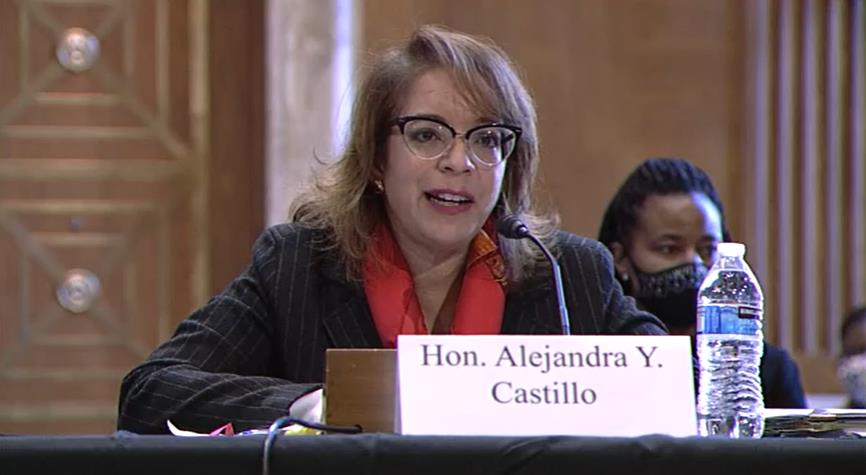Speeches/Remarks
Testimony by
The Honorable Alejandra Castillo
U.S. Assistant Secretary of Commerce for Economic Development
U.S. Economic Development Administration
United States Senate Committee on Environment and Public Works
November 3, 2021
INTRODUCTION

Assistant Secretary Alejandra Y. Castillo gives testimony to the Senate Environment & Public Works Committee regarding reauthorization of EDA.
Chairman Carper, Ranking Member Capito, and distinguished members of the Committee, thank you for this opportunity to testify on the importance of reauthorizing the U.S. Economic Development Administration (EDA).
While consensus can sometimes be hard to come by in Washington, I think that we can all agree that since EDA was last authorized in 2004 – 17 years ago – the economic conditions that our communities face have changed.
Over the last 17 years, new industries have emerged while other sectors have declined, regions have encountered and responded to devastating natural disasters, and we have all suffered the impacts of a global pandemic.
While EDA has grown exponentially in size and budget over the past 17 years – and especially over the past four years in response to disasters – this confluence of events represents a critical opportunity to reauthorize EDA.
Simply put, to be as supportive as possible to the communities and regions of today, EDA must evolve. We need to modernize our tools to provide the services that communities across the nation need to build contemporary, resilient economies. We need to update how we define distress so that our funding is more equitably distributed. To me, reauthorization is more than a technical process – it is essential for EDA to fulfill its historic mission.
Reauthorization will allow EDA to help our nation build back better by giving us the ability to implement programs in a way that further improves conditions in highly distressed communities and supports the following priorities: Equity, U.S. Competitiveness, Modern Infrastructure, and Resiliency.
Reauthorization is vitally important now to position EDA to respond to new economic development challenges, such as creating a healthy and sustainable energy sector that does not leave workers or communities behind, improving supply chain resilience, encouraging greater regional collaboration, and ensuring equitable economic growth that reaches the nation’s most underserved communities.
I am committed to working with this Committee and others in Congress to make sure EDA is reauthorized as soon as possible. It is that important. Only by reauthorizing EDA can we best help our communities – your communities – create positive outcomes.
Our collective goal must be to best position EDA to support the competitive, innovative, impactful economic development strategies that our communities are pursuing today to set the course forward to a brighter future.
I look forward to sharing ideas on how we can work together to meet these goals, but first I think it’s important to discuss the impact that EDA has had since we were established under EDA’s organic act, the Public Works and Economic Development Act of 1965 (PWEDA). I am particularly proud to report on EDA’s work over the past 10 months, leveraging Congress’ investments, including the CARES Act and the American Rescue Plan Act, in response to the unique challenges communities have faced as we build back better together.
[I will also note that we are standing ready to implement the tech hub program, RECOMPETE and pre-development work outlined in the President’s Build Back Better Act, if passed by Congress. The enormous response we received from our Build Back Better Regional Challenge – 529 applicants – shows the market and enthusiasm for these investments. The Infrastructure Investment and Jobs Act and the Build Back Better Act will allow us to continue to build back better by supporting underserved communities by building resilient economies, getting Americans back to work in good-paying jobs, and enhancing U.S. competitiveness on the global stage.]
Proudly, EDA has a long history of achievement, and an effective reauthorization effort will ensure that EDA is able to continue to deliver jobs and enhanced economic activity in struggling areas for decades to come. We are committed to building on our legacy of success.
BUILDING ON A LEGACY OF SUCCESS
Since the creation of the agency in 1965, EDA has provided tens of thousands of grants to state and local governments, non-profits, economic development districts (EDDs), economic development organizations, institutions of higher education, Tribal entities, and other organizations to help communities create jobs and generate private investment across the country.
Through PWEDA, EDA provides grants to communities who are distressed or recovering from the decline of major industries such as manufacturing and coal, and supports communities that have suffered the impacts of natural disasters, and now from the effects of the COVID-19 pandemic.
EDA provides targeted investments that address a range of economic development needs including research, planning, technical assistance, construction, workforce training, and entrepreneurship projects. Through its economic development assistance programs, EDA helps regions recover from economic setbacks and position themselves for long-term resiliency and sustainable economic growth.
Chairman Carper, Ranking Member Capito, I very much enjoyed visiting with you in Delaware and West Virginia, where we saw the impact of EDA’s investments firsthand!
In Delaware, at the gracious invitation of Senator Carper, we visited the University of Delaware’s incredible and impactful STAR campus.
There, a relatively small EDA investment of $516,000 supported the establishment of the DTP@STAR wet lab incubator, which supports our nation’s innovative spirit by offering flexible, state-of-the art incubation space and access to the resource development-stage that companies need to drive and accelerate their economic success. It was great being on the STAR Campus and feeling the entrepreneurial energy generated on that incredible campus.
I was also pleased to join Senators Capito and Manchin in Huntington, West Virginia, just days after being sworn in.
We visited Generation West Virginia, a statewide organization dedicated to attracting, retaining, and advancing young people in the state. We announced a $762,350 grant through the CARES Act to expand the organization’s NewForce program, which provides a tuition-free, remote, team-based intensive tech training program that equips graduates with in-demand software development skills and direct access to in-demand jobs. We heard from students about how this program is helping them grow their roots in West Virginia.
We also announced investments in Advantage Valley, Inc. through our Assistance to Coal Communities initiative under Economic Adjustment Assistance to provide technical assistance to manufacturing, engineering, and other businesses in a nine-county region to help them build their client bases by connecting them with new external markets and expand regional supply chains. We also announced an investment in Future of Nursing West Virginia to expand the West Virginia Nursing Entrepreneur Program to give nurses the skills they need to launch health-related businesses.
These are great examples of the diverse investments that EDA makes and their broad impact. They are also great examples of EDA’s commitment to ensuring that our coal communities have the resources they need to grow and thrive.
While most of the Members of this Committee and of Congress know similar EDA successes firsthand, we are proud that several academic studies clearly show the critical role that EDA plays in creating wealth and jobs in our communities.
ECONOMIC IMPACTS AND ASSESSMENTS
A number of independent studies have shown that EDA’s investments are highly effective and generate significant impacts for distressed communities, including catalyzing private investment and creating jobs. For distressed communities, this initial support can be the difference between falling even further behind or creating an economy that can support the community and its people into the future.
In many situations, EDA funds act as the primary catalyst for other funding – that is, without the support and funding of EDA, many projects would struggle to attract necessary capital. EDA grants act as a signaling mechanism to validate the project and mobilize outside investment. This finding has recently been validated by an ongoing EDA impact evaluation being conducted by the Urban Institute, which found that “EDA grants are highly leveraged (i.e., involving non-EDA financing), EDA funding represents 55 percent of the average construction project’s funding and 61 percent of the average non-construction project’s funding.” Moreover, in a study of infrastructure investments between 2000 and 2010, SRI International found that, for every dollar EDA invested, $17.5 in additional private investment dollars were generated.
EDA investments not only create the opportunity to leverage private investment, but they also have a concrete impact in the lives of Americans living in these communities. The SRI International study cited above analyzed the combined impact of EDA project costs and private investment generated and found that, in an average year, these projects generated an additional 56,554 jobs, $3.187 billion in wages and salaries, and $4.053 billion in personal income. From these results, SRI calculated that, on average, a new job was created for every $6,368 in EDA funding.
EDA recently concluded an internal assessment of infrastructure projects awarded between 2001 and 2015, using grantee reporting of the number of jobs created or retained as a direct result of EDA investments. This timeframe was used to allow us to focus our analysis on data reported at six years following an award (2021 being six years after 2015), which EDA has found to be its most informative timeframe following award in terms of projects being completed and response rates from grantees. This analysis confirmed the SRI findings that a new job was created for every $6,645 in EDA funding.
EDA continues to study our impact to ensure that these funds are being used effectively. The Urban Institute is conducting a study to assess impact from 2010 to 2020. Early findings indicate that “EDA construction projects are associated with an increased number of jobs located in neighborhoods (i.e., census tracts).” EDA will continue to update Congress and the public about these findings.
EDA GROWTH
Over the last several years, EDA has been called on time and time again to support communities through economic shocks, including those caused by transitioning economies, natural disasters, and the pandemic. We are growing and need the tools that reauthorization can provide so that we can best help our nation become more competitive.
Proudly, EDA has demonstrated its nimbleness through these many local, regional, and national crises and has changed and evolved to help communities respond while maximizing local strengths and insights.
EDA has improved its business practices to be more responsive to its customers, launched new evaluation tools and economic models, and, over the past four years, grown exponentially in size and budget.
In 2017, EDA had an annual appropriation of $276 million. In 2018 and 2019, through two disaster recovery supplementals, EDA’s budget authority grew to $901.5 million and $904 million, respectively. In 2020, Congress provided the agency a historic influx of $1.5 billion under the CARES Act, in addition to $333 million in annual appropriations. Less than one year later, on top of its $346 million 2021 appropriation, EDA has received an additional $3 billion in funding under the American Rescue Plan (ARP) Act of 2021, representing the largest economic development initiative for the Department of Commerce in decades – a once-in-a-lifetime chance to build back better.
This growth in appropriations has also resulted in rapid growth inside EDA. Using the temporary hiring authority received under the CARES Act, EDA successfully solicited and reviewed over 3,000 resumés and hired 83 staff, many within 30–60 days, which is well under the normal timeline. These new staff helped EDA obligate over two-thirds of the CARES Act funding within one year of Congress enacting the CARES Act and, as of October 11, 2021, EDA has obligated $1.385 billion of the $1.5 billion in CARES Act funding through 1,194 awards. EDA also continues to evaluate 121 applications and expects that those selected for funding will exhaust all of EDA’s CARES Act supplemental appropriation.
EDA is well positioned to obligate the $3 billion from the ARP Act by September 30, 2022. As of October 27, EDA has awarded 25 grants totaling $26 million in ARP funding. Thanks to the dedication and hard work of EDA’s existing staff, and additional hiring authorities, EDA expects to be able to obligate $4.5 billion in supplemental pandemic-related funding in approximately two and a half years.
ENSURING EFFECTIVENESS FOR THE FUTURE
While EDA has been exceedingly successful in creatively implementing its programs, our rapid growth in recent years and the ever-shifting economic development landscape means we must constantly reassess how we meet the challenges of the future. Through internal discussions and conversations with our key partners and stakeholders, we continue to decipher how the agency can optimally evolve and serve American communities.
We are committed to working with the committee to ensure that the updates to PWEDA will meet our shared vision of better serving communities across the nation and increasing U.S. competitiveness globally through updates focused on Modern Infrastructure, Disaster Recovery, and Equity.
I would like to now share some of our ideas on how to do that under a reauthorized EDA.
Modern Infrastructure:
First, infrastructure. As an agency engaged in building infrastructure, EDA needs to keep up to date with new types of infrastructure or infrastructure delivery to ensure that EDA can support communities in building key infrastructure necessary to compete in the modern economy and create and scale new industry sectors. These efforts will align with the work supported through the Infrastructure Investment and Jobs Act by providing grants for specific infrastructure projects that are small in scale but vitally important to the overall goals of the program. For example, modern economic development may involve building roads to connect a warehouse to a main thoroughfare to help accelerate the movement of goods in the supply chain as well as supporting the building the “last-mile” of broadband to connect new businesses in rural communities.
However, PWEDA is now over 50 years old, and was conceived with the aim of delivering traditional infrastructure like roads, water, and sewer. While those are all still critical, there are new 21st century technologies that communities need to be able to access, including broadband.
The pandemic shed light on just how important broadband infrastructure is to the economy, jobs, education, and health of a community and its residents.
Supporting broadband infrastructure development has never been more important. Broadband differs from traditional infrastructure, however, in that the provision of broadband service usually requires interconnection with private networks and the participation of an internet service provider, most of which are for-profit companies. Broadband service is thus an intrinsically public-private undertaking. As such, communities often have to be able to work with these companies on commercially attractive terms to ensure broadband is constructed in their area and operated effectively afterward.
Disaster Recovery:
As noted, over the past four years, EDA has increasingly been called on to play a prominent role in disaster recovery efforts, including two disaster supplementals in Fiscal Years 2018 and 2019 totaling $1.2 billion, $1.5 billion under the CARES Act, and now $3 billion under the ARP Act. EDA’s specialty in disaster situations is twofold: 1) providing immediate support through the Economic Recovery Support Function of the National Disaster Recovery Framework to assess the economic impacts of a disaster and help areas plan long-term recovery, and 2) through disaster supplementals and regular program funding, helping localities and regions recover from the impacts of changing climate and build back sustainably and resiliently. These roles are among the most important responsibilities that have been entrusted to us and have become large and consistent parts of EDA’s portfolio. EDA looks forward to working with the Committee to explore new authorizations to ensure that EDA is well-positioned to deliver its portfolio of disaster recovery tools smoothly and efficiently when called by upon by Congress to do so in the future.
Equity:
As the pandemic has painfully made clear, it is impossible to ignore the great inequality across our communities.
While EDA’s mission in itself directs us to support our nation’s neediest communities, we are today exploring new ways to support economic development planning or implementation projects that advance equity across America through investments that directly benefit: 1) one or more historically underserved populations, including but not limited to women, Black, Latino, and Indigenous and Native American persons, Asian Americans, and Pacific Islanders or 2) underserved communities within geographies that have been systemically and/or systematically denied a full opportunity to participate in aspects of economic prosperity, such as Tribal Lands, Persistent Poverty Counties, and rural areas with demonstrated, historical underservice.
In addition, EDA has identified three ways in which we can better serve these communities and help develop strong resilient economies across the country through reauthorization: updating EDA’s past distress criteria and grant rates, providing greater pre-development services, and strengthening the network of EDDs.
EDA’s existing distress criteria and grant rates have served it well for many years, but new measures of distress and our understanding of the best way to gauge long-standing inequity continue to evolve. To that end, EDA is assessing whether there are new or updated measures of distress that would better enable EDA to target its grants to the communities most in need of support. EDA looks forward to working with the Committee to help modernize EDA’s distress criteria and associate them with the right grant rate.
EDA has long engaged in pre-development activities including capacity-building, planning, technical assistance, and training. Support for pre-development activities have shown their worth over time and helps communities understand their needs and provides access to EDA or other federal funding. Through reauthorization, EDA could further build out its focus on pre-development activities as we look to ensure that all communities have the necessary tools to adapt, change, grow, and diversify their economies. We want to assist from “idea to implementation” by providing communities the resources and tools to build stronger, more resilient economies.
Throughout the response and recovery to the pandemic, EDA’s network of EDDs have never been more important, showing their value in helping develop and adapt regional recovery plans to help communities build back stronger and more resilient, while also developing and managing key economic development projects in various jurisdictions. EDA hopes to build on its long-standing partnership with EDDs and strengthen our relationship with these important regional service providers through reauthorization.
As we continue to assess how best to position EDA for future success, we look forward to working closely with our stakeholders, other federal agencies, and Congress.
CONCLUSION
Chairman Carper, Ranking Member Capito, Members of the Committee, thank you for consistent engagement and the opportunity to address you today.
As I’ve pledged, I am committed to ensuring that EDA is running on all cylinders so that we are best able to meet the needs of our communities while remaining nimble and responsive as we grow.
Our accomplishments reflect our commitment to encourage collaborative regional economic development, promote innovation, cultivate entrepreneurship, build a well-qualified workforce, and position our economic development partners to be more resilient, agile, and competitive in the global marketplace.
We must continue to evolve to meet the growing demands of our communities. I have outlined some important ways in which we can work together through reauthorization to position EDA and our communities for future success. I am excited to be working with you on the reauthorization of EDA.
Restoring economic prosperity to all parts of the nation is an important priority of the Administration and we look forward to working with you to reauthorize EDA so that we are best positioned to leverage its strengths in furtherance of this goal.
I look forward to answering any questions you may have.
###









